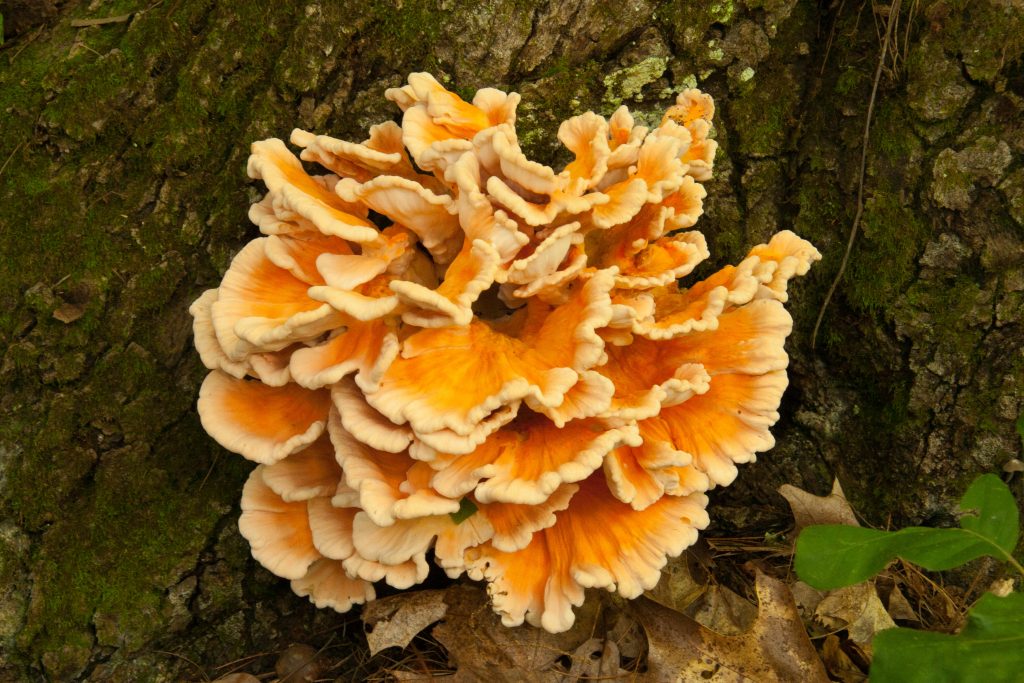
Chicken of the Woods (aka sulphur shelf, aka chicken mushroom) actually refers to several mushrooms in the genus Laetiporus. L. sulphureus is generally considered a fall mushroom, and L. cincinnatus is usually found in mid-summer in my part of the world. Both are easy to spot thanks to their vibrant color. Foragers sometimes call them 50-mile-an-hour mushrooms, because they really stand out in the landscape.
Some people have allergic reactions to chicken mushrooms. (My condolences if you are one of those people.) If you’ve never eaten Chicken of the Woods before, try a small amount the first time. This is a good idea with any new food, whether it’s from the woods or from the supermarket. That way, if you have a reaction, it will be manageable.
Chicken of the Woods is a polypore mushroom. That means that, unlike toadstools, the underside of this mushroom has pores, not gills. It’s a bracket fungus that grows on dead or dying wood. Someone, somewhere, thought this mushroom tasted like chicken (hence its name) but I disagree. True, it’s got a dense texture that can substitute for chicken in soups or casseroles, but the flavor is definitely fungal.
Chicken of the Woods is bright orange, and the undersides are either yellow (L. sulphureus) or white (L. cincinnatus), depending on the species. Both are delicious and easy to identify, making them excellent mushrooms for beginning foragers.
Chickens are large, perennial mushrooms, coming back year after year until they kill their host tree, then coming back a few years after that until all the wood’s nutrients are exhausted. They grow equally well in the shade of mixed woods and the full sun of city parks.
Chicken of the Woods gets tough as it ages (although L. cincinnatus is generally considered to be more tender than L. sulphureus), so break off a piece before you harvest. If the central core of the mushroom feels woody, you may be able to trim tender, new growth from the outer edges of the brackets. Use a knife to cut the brackets off the bark and look in between them for insects. Chickens that are past their prime may harbor many different forms of insect life!
If you’re lucky enough to find a young chicken, emerging from a tree trunk or log with just a blush of orange on its young, pliable flesh, don’t hesitate! It may be smaller than a mature specimen, but the tender texture and delicate taste are superb. If you find a chicken slightly past its prime, but still bug free, it’s worth taking home to make stock or duxelles.
Chicken mushrooms can grow to be quite large, so if you bring home more than you’ll use right away, give the mushroom a rough chop, sauté in butter or oil, and freeze. This is the preservation method that best maintains the texture and flavor of the mushroom. You can dry chicken mushrooms in a dehydrator, but they never become fully succulent when rehydrated. I only do this if I’m going to powder the mushroom to use in soup or stews.

I have read that chickens that grow on anything but hardwood trees are toxic. Do you find this to be true?
I can’t speak from personal experience as I’ve only found them on oaks. But what I’ve read indicates that the chickens that grow on eucalyptus, pine, and other conifers are actually different species, not L. sulphureus or L. cincinnatus. This page will give you more info; scroll about 3/4 of the way down to read about the different species. http://botit.botany.wisc.edu/toms_fungi/jul2001.html
i believe you can also find them growing on hemlock as well which should be avoided.
Do you have any suggestions on using the tougher core part? I was thinking about dehydrating it and powdering it to use in soups and stews.
That’s a good idea, and I do it often. You might also consider making duxelles.
How about a c-of-woods that has dried on the tree. Can that be reconstituted?
I’ve never tried that, and my first instinct says no. CoW isn’t best preserved by drying, unless you’re going to powder it and use it as a spice. I have found they don’t reconstitute fully and the rehydrated texture is never what I want it to be. If you decide to try it, please let me know how it goes.
Excellent! Thanks 🙂